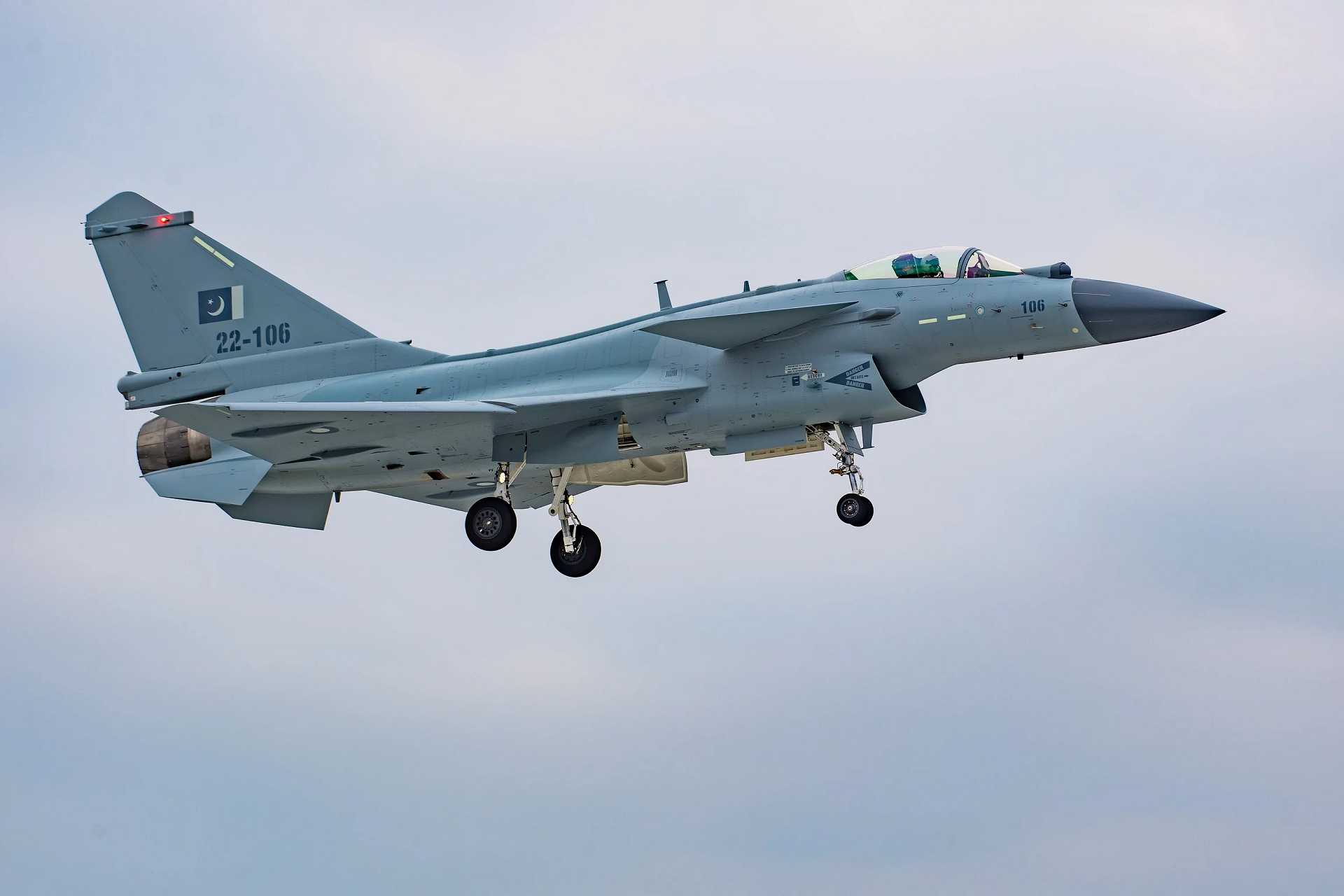Breaking News: First French Rafale Fighter Jet Loss? Pakistani J-10C from China May Have Used PL-15 to Down Indian Rafale

{loadposition bannertop}
{loadposition sidebarpub}
Amid the steadily intensifying standoff between India and Pakistan, speculation has erupted around the alleged shootdown of an Indian Air Force Rafale fighter jet by a Pakistani J-10C aircraft using a PL-15 beyond-visual-range missile. Though the Indian government has categorically denied any such loss, and no physical confirmation has yet been made public, the incident—if true—would represent a landmark moment in regional military history. It would not only be the first known combat loss of a Rafale fighter but also a significant validation of China’s long-range air-to-air missile technology as deployed by Pakistan.Follow Army Recognition on Google News at this link
A Chinese-made J-10C multirole fighter jet of the Pakistani Air Force, reportedly involved in a long-range engagement with an Indian Rafale using the PL-15 missile. This marks a potential first combat loss of a French-built Rafale, pending official confirmation. (Picture source: REDDIT)
The backdrop to this alleged engagement is the Indian Air Force’s Operation Sindoor, a series of coordinated airstrikes on May 6 targeting what New Delhi describes as militant infrastructure across Pakistan-administered Kashmir and strategic nodes in Punjab province. Pakistan’s military response was swift. It reportedly scrambled several squadrons of frontline aircraft, including its latest acquisition from China: the Chengdu J-10C. According to the Inter-Services Public Relations (ISPR), Pakistan’s air defense operations resulted in the downing of five Indian aircraft. Among them, it claims, were three Rafales, one of which was struck by a PL-15 missile launched from a J-10C fighter during a high-altitude, long-range engagement.
India has vigorously denied these assertions. Officials from the Ministry of Defence rejected the claims outright, while the Press Information Bureau accused Pakistan of spreading disinformation, noting that several images and videos shared online purportedly showing wreckage had been recycled from unrelated events. Nevertheless, the controversy gained traction when a report from a French intelligence official, cited by CNN, suggested that at least one Rafale had been lost in the engagement zone, though without confirming the cause or the identity of the attacking platform.
At the heart of this confrontation are two of the most advanced 4.5-generation fighter jets in South Asia: the French Dassault Rafale and the Chinese Chengdu J-10C. Each represents a distinct philosophy in modern air combat.
The Rafale, twin-engined and delta-winged, is optimized for multirole performance. It is powered by two Snecma M88-2 turbofans, achieving speeds up to Mach 1.8 with a combat radius exceeding 1,850 kilometers. The aircraft’s strength lies in its sensor fusion and survivability systems, particularly the RBE2-AA AESA radar and the SPECTRA electronic warfare suite, which provides 360-degree threat detection and countermeasures. The Rafale is also equipped with the MBDA Meteor missile, one of the most lethal BVR weapons in the world, with a range of over 150 kilometers and an expansive no-escape zone.
Facing off against it is the J-10C, the crown jewel of Pakistan’s recent modernization efforts. This single-engine multirole fighter, powered by the WS-10B engine, reaches Mach 2 and features a digital fly-by-wire system. It incorporates the KLJ-7A AESA radar and is compatible with China’s most advanced air-to-air missile: the PL-15. The J-10C is not just a lightweight strike fighter—it is a platform designed to outmatch regional adversaries in radar-guided BVR combat.
The PL-15 missile has become central to the debate surrounding this alleged engagement. Developed by the Luoyang Electro-Optical Research Institute, the PL-15 is powered by a dual-pulse solid-fuel motor and is believed to have an operational range of 200 to 300 kilometers. It features an active radar seeker for terminal guidance and inertial navigation with mid-course datalink updates. Its design emphasizes defeating sophisticated electronic countermeasures and targeting high-value aerial assets, such as tankers and AWACS. The PL-15’s existence has been seen by analysts as a direct response to Western BVR threats like the AIM-120D and the Meteor—and in theory, it rivals or surpasses them in range.
If a PL-15-armed J-10C did indeed neutralize a Rafale in combat, the implications are considerable. It would suggest not only a shift in tactical air superiority but a broader realignment of regional power dynamics. While India fields a diverse and numerically superior air force—including Su-30MKIs, MiG-29s, Mirage 2000s, and indigenous Tejas fighters—Pakistan’s focused investments in electronic warfare and missile reach may have introduced an asymmetric capability that challenges India’s technological edge.
Such a scenario also signals the transformation of air warfare into a domain where electronic warfare, radar range, and missile kinematics matter more than traditional dogfighting ability. In that context, the Rafale’s superiority in maneuverability and close-combat survivability may not be sufficient in a scenario where the first shot, fired from beyond 100 kilometers, determines the outcome.
Though the story remains unconfirmed, its very existence in media and strategic discourse shows how modern conflict now includes an information dimension, where perception and narrative are nearly as influential as kinetic action. Until wreckage is found, telemetry logs are released, or eyewitness accounts emerge, the truth of the Rafale’s fate will remain speculative.
However, this incident—real or not—demonstrates the rapidly evolving technological competition between India and Pakistan, and how platforms like the Rafale and the J-10C, armed with weapons like the Meteor and the PL-15, are redefining what air dominance means in 21st-century South Asia.

{loadposition bannertop}
{loadposition sidebarpub}
Amid the steadily intensifying standoff between India and Pakistan, speculation has erupted around the alleged shootdown of an Indian Air Force Rafale fighter jet by a Pakistani J-10C aircraft using a PL-15 beyond-visual-range missile. Though the Indian government has categorically denied any such loss, and no physical confirmation has yet been made public, the incident—if true—would represent a landmark moment in regional military history. It would not only be the first known combat loss of a Rafale fighter but also a significant validation of China’s long-range air-to-air missile technology as deployed by Pakistan.
Follow Army Recognition on Google News at this link
A Chinese-made J-10C multirole fighter jet of the Pakistani Air Force, reportedly involved in a long-range engagement with an Indian Rafale using the PL-15 missile. This marks a potential first combat loss of a French-built Rafale, pending official confirmation. (Picture source: REDDIT)
The backdrop to this alleged engagement is the Indian Air Force’s Operation Sindoor, a series of coordinated airstrikes on May 6 targeting what New Delhi describes as militant infrastructure across Pakistan-administered Kashmir and strategic nodes in Punjab province. Pakistan’s military response was swift. It reportedly scrambled several squadrons of frontline aircraft, including its latest acquisition from China: the Chengdu J-10C. According to the Inter-Services Public Relations (ISPR), Pakistan’s air defense operations resulted in the downing of five Indian aircraft. Among them, it claims, were three Rafales, one of which was struck by a PL-15 missile launched from a J-10C fighter during a high-altitude, long-range engagement.
India has vigorously denied these assertions. Officials from the Ministry of Defence rejected the claims outright, while the Press Information Bureau accused Pakistan of spreading disinformation, noting that several images and videos shared online purportedly showing wreckage had been recycled from unrelated events. Nevertheless, the controversy gained traction when a report from a French intelligence official, cited by CNN, suggested that at least one Rafale had been lost in the engagement zone, though without confirming the cause or the identity of the attacking platform.
At the heart of this confrontation are two of the most advanced 4.5-generation fighter jets in South Asia: the French Dassault Rafale and the Chinese Chengdu J-10C. Each represents a distinct philosophy in modern air combat.
The Rafale, twin-engined and delta-winged, is optimized for multirole performance. It is powered by two Snecma M88-2 turbofans, achieving speeds up to Mach 1.8 with a combat radius exceeding 1,850 kilometers. The aircraft’s strength lies in its sensor fusion and survivability systems, particularly the RBE2-AA AESA radar and the SPECTRA electronic warfare suite, which provides 360-degree threat detection and countermeasures. The Rafale is also equipped with the MBDA Meteor missile, one of the most lethal BVR weapons in the world, with a range of over 150 kilometers and an expansive no-escape zone.
Facing off against it is the J-10C, the crown jewel of Pakistan’s recent modernization efforts. This single-engine multirole fighter, powered by the WS-10B engine, reaches Mach 2 and features a digital fly-by-wire system. It incorporates the KLJ-7A AESA radar and is compatible with China’s most advanced air-to-air missile: the PL-15. The J-10C is not just a lightweight strike fighter—it is a platform designed to outmatch regional adversaries in radar-guided BVR combat.
The PL-15 missile has become central to the debate surrounding this alleged engagement. Developed by the Luoyang Electro-Optical Research Institute, the PL-15 is powered by a dual-pulse solid-fuel motor and is believed to have an operational range of 200 to 300 kilometers. It features an active radar seeker for terminal guidance and inertial navigation with mid-course datalink updates. Its design emphasizes defeating sophisticated electronic countermeasures and targeting high-value aerial assets, such as tankers and AWACS. The PL-15’s existence has been seen by analysts as a direct response to Western BVR threats like the AIM-120D and the Meteor—and in theory, it rivals or surpasses them in range.
If a PL-15-armed J-10C did indeed neutralize a Rafale in combat, the implications are considerable. It would suggest not only a shift in tactical air superiority but a broader realignment of regional power dynamics. While India fields a diverse and numerically superior air force—including Su-30MKIs, MiG-29s, Mirage 2000s, and indigenous Tejas fighters—Pakistan’s focused investments in electronic warfare and missile reach may have introduced an asymmetric capability that challenges India’s technological edge.
Such a scenario also signals the transformation of air warfare into a domain where electronic warfare, radar range, and missile kinematics matter more than traditional dogfighting ability. In that context, the Rafale’s superiority in maneuverability and close-combat survivability may not be sufficient in a scenario where the first shot, fired from beyond 100 kilometers, determines the outcome.
Though the story remains unconfirmed, its very existence in media and strategic discourse shows how modern conflict now includes an information dimension, where perception and narrative are nearly as influential as kinetic action. Until wreckage is found, telemetry logs are released, or eyewitness accounts emerge, the truth of the Rafale’s fate will remain speculative.
However, this incident—real or not—demonstrates the rapidly evolving technological competition between India and Pakistan, and how platforms like the Rafale and the J-10C, armed with weapons like the Meteor and the PL-15, are redefining what air dominance means in 21st-century South Asia.






